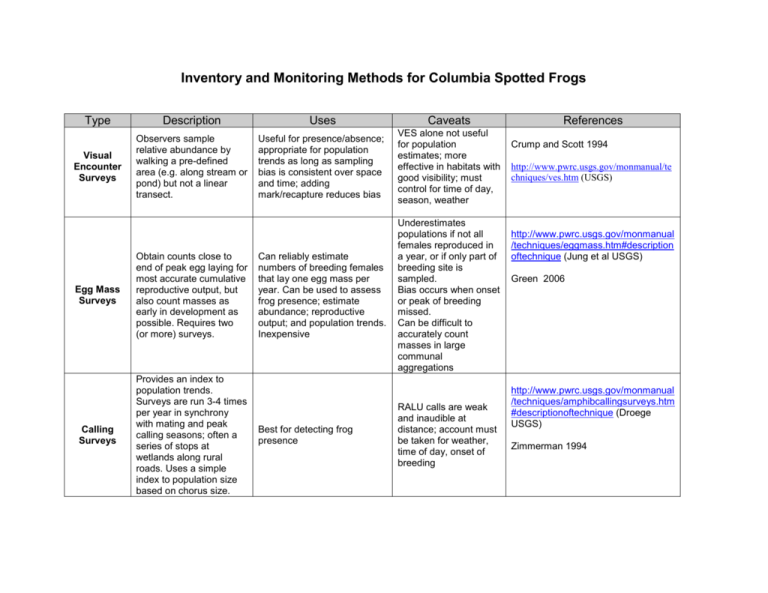Comparison of Inventory and Monitoring Methods
advertisement

Inventory and Monitoring Methods for Columbia Spotted Frogs Type Visual Encounter Surveys Description Observers sample relative abundance by walking a pre-defined area (e.g. along stream or pond) but not a linear transect. Egg Mass Surveys Obtain counts close to end of peak egg laying for most accurate cumulative reproductive output, but also count masses as early in development as possible. Requires two (or more) surveys. Calling Surveys Provides an index to population trends. Surveys are run 3-4 times per year in synchrony with mating and peak calling seasons; often a series of stops at wetlands along rural roads. Uses a simple index to population size based on chorus size. Uses Caveats Useful for presence/absence; appropriate for population trends as long as sampling bias is consistent over space and time; adding mark/recapture reduces bias VES alone not useful for population estimates; more effective in habitats with good visibility; must control for time of day, season, weather Can reliably estimate numbers of breeding females that lay one egg mass per year. Can be used to assess frog presence; estimate abundance; reproductive output; and population trends. Inexpensive Underestimates populations if not all females reproduced in a year, or if only part of breeding site is sampled. Bias occurs when onset or peak of breeding missed. Can be difficult to accurately count masses in large communal aggregations Best for detecting frog presence RALU calls are weak and inaudible at distance; account must be taken for weather, time of day, onset of breeding References Crump and Scott 1994 http://www.pwrc.usgs.gov/monmanual/te chniques/ves.htm (USGS) http://www.pwrc.usgs.gov/monmanual /techniques/eggmass.htm#description oftechnique (Jung et al USGS) Green 2006 http://www.pwrc.usgs.gov/monmanual /techniques/amphibcallingsurveys.htm #descriptionoftechnique (Droege USGS) Zimmerman 1994 Funnel Trapping Drift Fences Traps are placed in thalweg, along stream margins, or in ponds and secured; no bait necessary A barrier fence around breeding pond with pit traps on either side Useful for capturing migrating adults or larvae at night; best for presence/absence or relative abundance; if placed in migratory corridors may be used to estimate breeding population Good for long-term population studies; gives accurate counts and movement patterns of breeding adults Adams 1997 Must be checked frequently; may attract predators Labor intensive, requires maintenance and daily checks; may attract predators Dodd and Scott 1994 Metts and Graeter 2006 Adams, M., Richter, K., and W. Leonard. 1997. Surveying and monitoring amphibians using aquatic funnel traps. pp 4754. In Olson, D., Leonard, W., and R. B. Bury (eds). Sampling amphibians in lentic habitats: methods and approaches for the Pacific Northwest. Soc. for Northwestern Vertebrate Biology, Olympia, WA. Crump, M., and N. Scott. 1994. Visual encounter surveys. pp 84-92. in Heyer, W. and others (eds). Measuring and monitoring biological diversity—standard methods for amphibians. Smithsonian Inst. Press, Washington. Dodd, C., and D. Scott. 1994. Drift fences encircling breeding sites. pp 125-130. in Heyer, W. and others (eds). Measuring and monitoring biological diversity—standard methods for amphibians. Smithsonian Inst. Press, Washington. Green, A. (in prep.) Egg mass and nest counts. pp 74-76. In Graeter, G., Buhlmann, K., Wilkinson, L., and J. W. Gibbons. Inventory and monitoring: recommended techniques for reptiles and amphibians, with application to the US and Canada. PARC Tech. Rep. Aiken, SC. Metts, B., and G. Graeter. (in prep.). Terrestrial drift fences and pitfall traps. In Graeter, G., Buhlmann, K., Wilkinson, L., and J. W. Gibbons. Inventory and monitoring: recommended techniques for reptiles and amphibians, with application to the US and Canada. PARC Tech. Rep. Aiken, SC. Zimmerman, B. 1994. Audio strip transects. pp 92-97. In Heyer, W. and others (eds). Measuring and monitoring biological diversity—standard methods for amphibians. Smithsonian Inst. Press, Washington. Prepared by Cynthia Tait, January 2008.






